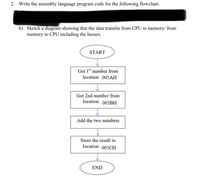
Systems Architecture
7th Edition
ISBN: 9781305080195
Author: Stephen D. Burd
Publisher: Cengage Learning
expand_more
expand_more
format_list_bulleted
Concept explainers
Question
thumb_up100%
Subject microprocessor

Transcribed Image Text:2. Write the assembly language program code for the following flowchart.
b) Sketch a diagram showing that the data transfer from CPU to memory/ from
memory to CPU including the busses.
START
Get 1" number from
location 005AH
Get 2nd number from
location 005BH
Add the two numbers
Store the result in
location 005CH
END
Expert Solution
This question has been solved!
Explore an expertly crafted, step-by-step solution for a thorough understanding of key concepts.
This is a popular solution
Trending nowThis is a popular solution!
Step by stepSolved in 2 steps

Knowledge Booster
Learn more about
Need a deep-dive on the concept behind this application? Look no further. Learn more about this topic, computer-science and related others by exploring similar questions and additional content below.Similar questions
- (For thought) a. What’s an advantage of namespaces? b. What’s a possible disadvantage of namespaces?arrow_forward_____ is a CPU design technique in which instruction execution is divided into multiple stages and different instructions can execute in different stages simultaneously.arrow_forwardA(n) __________ is a storage location implemented in the CPU.arrow_forward
- In the ________, memory addresses consist of a single integer.arrow_forwardA CPU is a(n) __________ processor capable of performing many different tasks simply by changing the program.arrow_forwardMost Intel CPUs use the __________, in which each memory address is represented by two integers.arrow_forward
- 1. Mark the following statements as true or false. a. The calculating device called the Pascaline could calculate sums up to eight figures long. (1) b. All programs must be loaded into the CPU before they can be executed and all data must be loaded into main memory before it can be manipulated. (2) c. Main memory is an ordered sequence of cells and each cell has a random location in main memory. (2) d. The program that loads first when you turn on your computer is called the operating system. (2) e. Analog signals represent information with a sequence of 0s and 1s. (3) f. The machine language is a sequence of 0s and 1s. (3) g. A Binary code is a sequence of 0s and 1s. (3) h. A sequence of eight bits is called a byte. (3) i. One GB is MB. (3) j. In ASCII, A is the 65th character. (3) k. The number system used by a computer is base 2. (3) l. An assembler translates the assembly language instructions into machine language. (4) m. A compiler translates the source program into an object program. n. In a program, statements that begin with the symbol are called preprocessor directives (7) o. An object program is the machine language version of a high-level language program. (9) p. All logical errors, such as division by 0, are reported by the compiler. (9) q. In object-oriented design (OOD), a program is a collection of interacting objects. (10) r. An object consists of data and operations on that data. (10) s. ISO stands for International Organization for Standardization. (11)arrow_forward(Computation) Among other applications, Pascal’s triangle (see Figure 7.22) provides a means of determining the number of possible combinations of n things taken r at a time. For example, the number of possible combinations of five people (n = 5) taken two at a time (r=2)is10. Each row of the triangle begins and ends with 1. Every other element in a row is the sum of the element directly above it with the element to the left of the one above it. That is, element[n][r]=element[n1][r]+element[n1][r1] Using this information, write and test a C++ program to create the first 11 rows of a twodimensional array representing Pascal’s triangle. For any given value of n less than 11 and r less than or equal to n, the program should display the correct element. Use your program to determine in how many ways a committee of 8 can be selected from a group of 10 peoplearrow_forward(Practice) Determine data types appropriate for the following data: a. The average of four grades b. The number of days in a month c. The length of the Golden Gate Bridge d. The numbers in a state lottery e. The distance from Brooklyn, NY to Newark, NJ f. The single-character prefix that specifies a component typearrow_forward
- (Practice) State whether the following are valid function names and if so, whether they’re mnemonic names that convey some idea of the function’s purpose. If they are invalid names, state why. powerdensity m1234 newamp 1234 abcd total tangent absval computed b34a 34ab volts$ a2B3 while minVal sine $sine cosine speed netdistance sum return stackarrow_forward(Practice) Show how the name KINGSLEY is stored in a computer that uses the ASCII code by drawing a diagram similar to Figure 2.7, shown previously.arrow_forward
arrow_back_ios
arrow_forward_ios
Recommended textbooks for you
 Systems ArchitectureComputer ScienceISBN:9781305080195Author:Stephen D. BurdPublisher:Cengage Learning
Systems ArchitectureComputer ScienceISBN:9781305080195Author:Stephen D. BurdPublisher:Cengage Learning C++ for Engineers and ScientistsComputer ScienceISBN:9781133187844Author:Bronson, Gary J.Publisher:Course Technology PtrProgramming Logic & Design ComprehensiveComputer ScienceISBN:9781337669405Author:FARRELLPublisher:Cengage
C++ for Engineers and ScientistsComputer ScienceISBN:9781133187844Author:Bronson, Gary J.Publisher:Course Technology PtrProgramming Logic & Design ComprehensiveComputer ScienceISBN:9781337669405Author:FARRELLPublisher:Cengage EBK JAVA PROGRAMMINGComputer ScienceISBN:9781337671385Author:FARRELLPublisher:CENGAGE LEARNING - CONSIGNMENT
EBK JAVA PROGRAMMINGComputer ScienceISBN:9781337671385Author:FARRELLPublisher:CENGAGE LEARNING - CONSIGNMENT Principles of Information Systems (MindTap Course...Computer ScienceISBN:9781285867168Author:Ralph Stair, George ReynoldsPublisher:Cengage Learning
Principles of Information Systems (MindTap Course...Computer ScienceISBN:9781285867168Author:Ralph Stair, George ReynoldsPublisher:Cengage Learning Microsoft Visual C#Computer ScienceISBN:9781337102100Author:Joyce, Farrell.Publisher:Cengage Learning,
Microsoft Visual C#Computer ScienceISBN:9781337102100Author:Joyce, Farrell.Publisher:Cengage Learning,

Systems Architecture
Computer Science
ISBN:9781305080195
Author:Stephen D. Burd
Publisher:Cengage Learning

C++ for Engineers and Scientists
Computer Science
ISBN:9781133187844
Author:Bronson, Gary J.
Publisher:Course Technology Ptr

Programming Logic & Design Comprehensive
Computer Science
ISBN:9781337669405
Author:FARRELL
Publisher:Cengage

EBK JAVA PROGRAMMING
Computer Science
ISBN:9781337671385
Author:FARRELL
Publisher:CENGAGE LEARNING - CONSIGNMENT

Principles of Information Systems (MindTap Course...
Computer Science
ISBN:9781285867168
Author:Ralph Stair, George Reynolds
Publisher:Cengage Learning

Microsoft Visual C#
Computer Science
ISBN:9781337102100
Author:Joyce, Farrell.
Publisher:Cengage Learning,